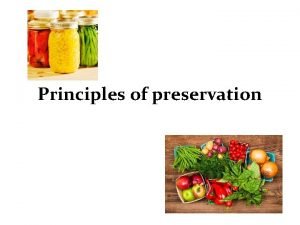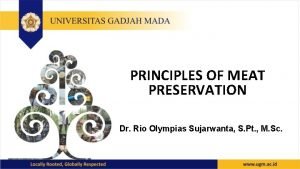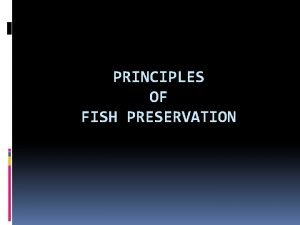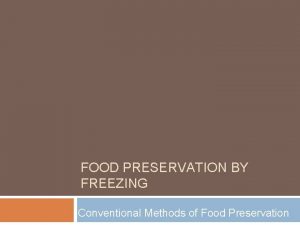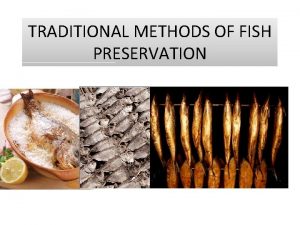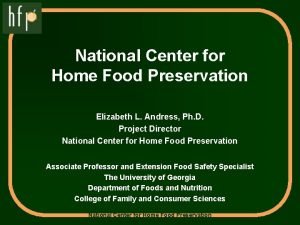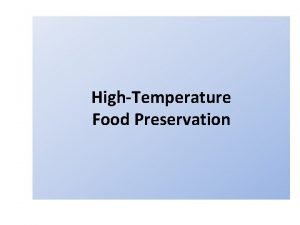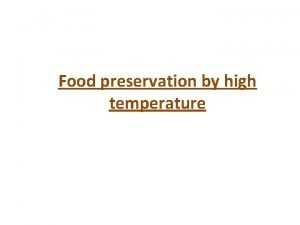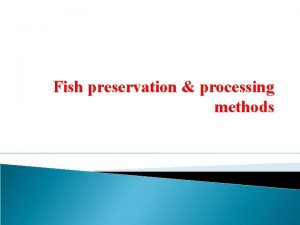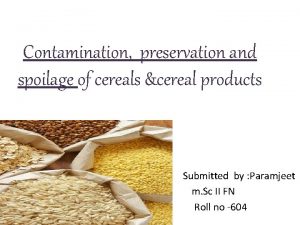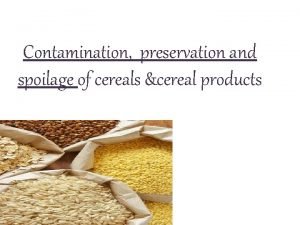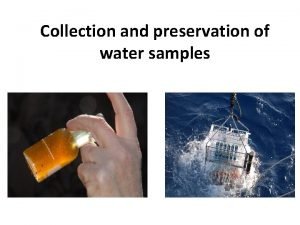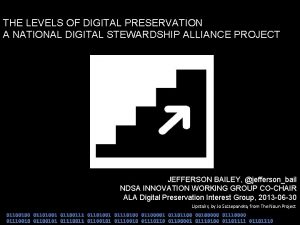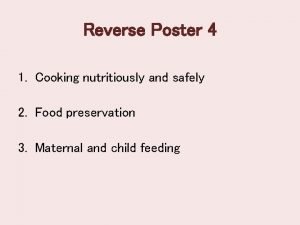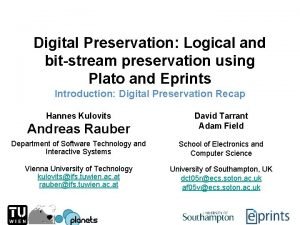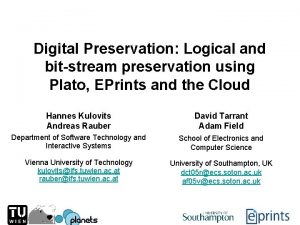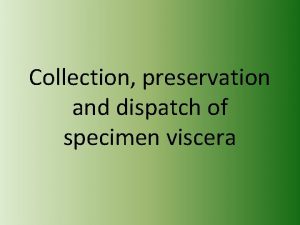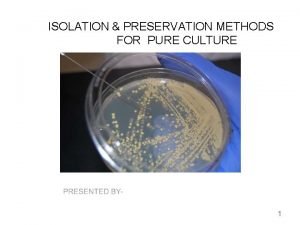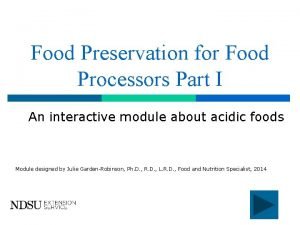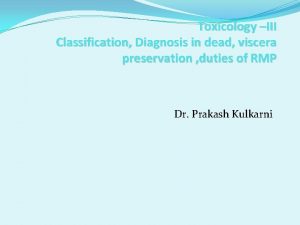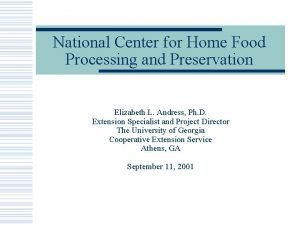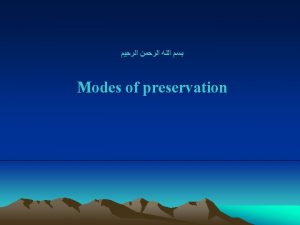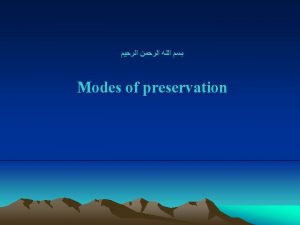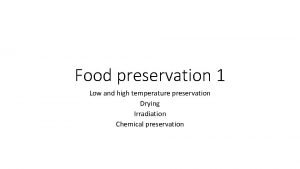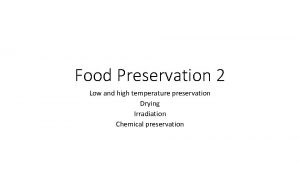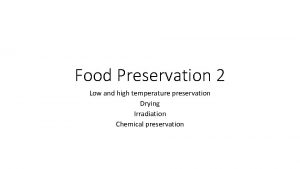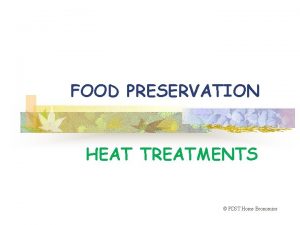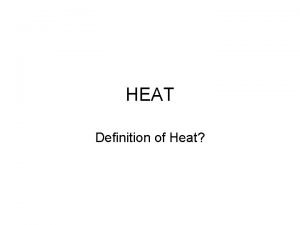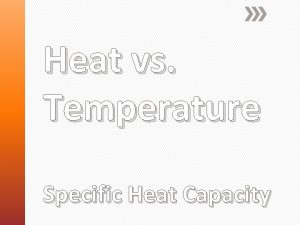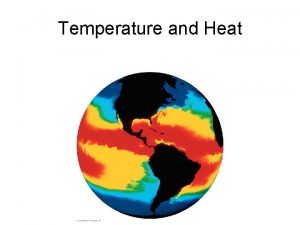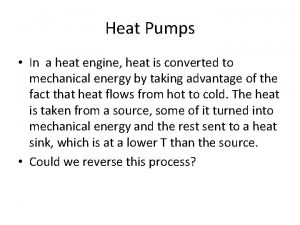Principles of preservation Principles Of Preservation HEAT LOW







































- Slides: 39

Principles of preservation

Principles Of Preservation • HEAT • LOW TEMPERATURE • CHEMICALS • FERMENTATION • CANNING • BOTTLING • ULTRA-VIOLET AND IONIZING RADIATION

Methods of food preservation 1. Physical methods 2. Chemical methods 3. Fermentation 4. Other methods: with combination of one or other methods

Physical methods

A. By removal of heat • Preservation by cold • Methods i. Refrigerator ii. Freezing iii. Dehydro freezing iv. Carbonation

b. By addition of heat • Thermal processing • Methods: i. Pasteurization ii. Sterilization iii. HTST iv. Hurdle technology

Principles Of Food Preservation By Heat • Application of heat to the foods leads to the destruction of microorganisms • The specific treatment varies with: i) The organisms that has to be killed ii) The nature of the food to be preserved and iii) Other means of preservation that may be used in addition to high temperature

Methods of drying • By removal of heat (by cold): refrigeration, freezing, carbonation • By addition of heat: pasteurization, sterilization, thermal heating, HTST • Removal of water: sun drying, dehydration, freeze drying, foam mat drying, puff drying

High temperatures used for preservation (1) Pasteurization temperature – below 100 o. C (2)Heating at about 100 o. C and (3) Sterilization temperature above 100 o. C

a. Pasteurization • Pasteurization is a heat treatment that kills part but not all the microorganisms present and the temperature applied is below 100 o. C • The heating may be by means of steam, hot H 2 O, dry heat or electric currents and the products are cooled promptly after the heat treatments • The surviving microorganisms are inhibited by low temperature (or) some other preservative method if spoilage is to be prevented • Preservative methods used to supplement pasteurization include (i) refrigeration e. g. of milk (ii) keeping out microorganisms usually by packaging the product in a sealed container (iii) maintenance of anaerobic conditions as in evacuated, sealed containers (iv) addition of high concentration of sugar, as in sweetened condensed milk and (v) Presence (or) addition of chemical preservatives e. g. the organic acids on pickles

Methods of pasteurization • HTST method - High temperature and short time (above 70 o. C) • LTH method - Low temperature and higher time (or) Holding method (60 -70 o. C)

b. Heating at about 100 o. C • A temperature of approximately 100 o. C is obtained by boiling a liquid food, by immersion of the container of food in boiling water or by exposure to flowing steam. Some very acid foods, e. g. , sauerkraut may be preheated to a temperature somewhat below 100 o. C, packaged hot, and not further heat processed • Blanching fresh vegetables before freezing or drying involves heating briefly at about 100 o. C

c. Sterilization-above 100 o. C • By this method all microorganisms are completely destroyed due to high temperature • The time and temperature, necessary for sterilization vary with the type of food • Temperatures above 100 o C can only be obtained by using steam pressure sterilizers such as pressure cookers and autoclaves • Fruits and tomato products should be noted at 100 o. C for 30 min. so that the spore forming bacteria which are sensitive to high acidity may be completely killed • Vegetables like green peas, okra, beans, etc. being non acidic and containing more starch than sugar, require • higher temperature to kill the spore forming organisms. Continuous heating for 30 -90 min. at 116 o. C is essential for their sterilization. • Before using, empty cans and bottles should also be sterilized for about 30 min. by placing them in boiling water


PRESERVATION BY LOW TEMPERATURE • Microbial growth and enzyme reactions are retarded in foods stored at low temperature • The lower the temperature, the greater the retardation • Low temperature can be produced by many methods

(a) Cellar storage (about 15 o. C) • The temperature in cellar (underground rooms) where surplus food is stored in many villages is usually not much below that of the outside air and is seldom lower than 15 o. C. • It is not enough to prevent the action of many spoilage organisms or of plant enzymes. • Root crops, potatoes, cabbage, apples, onions and similar foods can be stored for limited periods during the winter months.

(b) Refrigerated (or) chilling (0 to 5 o. C) • Chilling temperature are obtained and maintained by means of ice or mechanical refrigeration. It may be used as the main preservative method for foods or for temporary preservation until some other preservative process is applied • Most perishable foods, including eggs, dairy products, meats, sea foods, vegetables and fruits, may be held in chilling storage for Factors to be considered in connection with chilling storage include the temperature of chilling, the relative humidity, air velocity and composition of the atmosphere in the store room, and the possible use of ultra violet rays or other radiations.

PRESERVATION BY CHEMICALS • A preservative is defined as only substance which is capable of inhibiting, retarding or arresting the growth of microorganisms. • Microbial spoilage of food products is also controlled by using chemical preservatives. • The inhibitory action of preservatives is due to their interfering with the mechanism of cell division, permeability of cell membrane and activity of enzymes.

c. By removal of water • Evaporation or dehydration • Methods: i. Sun drying ii. Dehydration iii. Low temperature evaporation iv. Freeze drying v. Accelerated freeze drying vi. Foam mat drying vii. Puff drying

d. Irradiation: • Dosing using radiation • Gamma rays for drying and preservation • Fish, onion, potato

II. Chemicals used • Acid: vinegar, lactic acid in pickles, fish, meat • Salt (brining/blanching): pickles, canning • Sugar: jam, squash, jellies • Chemical preservatives: KMS and sodium benzoate

• Two important chemical preservatives are permitted to beverages according to the FPO (1955): • 1. Sulphur dioxide and • 2. Benzoic acid

Sulphur dioxide • It is widely used throughout the world in the preservation of juice, pulp, nectar, squash, crush, cordial and other products. It has good preserving action against bacteria and moulds and inhibits enzymes, etc. • In addition, it acts as an antioxidant and bleaching agent. • These properties help in the retention of ascorbic acid, carotene and other oxidizable compounds. • It also retards the development of nonenzymatic browning or discolouration of the product. • It is generally used in the form of its salts such as sulphite, bisulphate and metabisulphite. • Potassium metabisulphite (K 2 O 2 So 2 (or) K 2 S 2 O 5) is commonly used as a stable source of So 2.

Being a solid, it is easier to use than liquid (or) gaseous So 2. It is fairly stable in neutral (or) alkaline media but decomposed by weak acids like carbonic, citric, tartaric acid and malic acids. When added to fruit juice (or) squash it reacts with the acid in the juice forming thepotassium salt and So 2, which is liberated and forms sulphurous acid with the water of the juice. The reactions involved are as follows:

• SO 2 has a better preservative action than sodium benzoate against bacteria and moulds. It also retards the development of yeasts in juice, but cannot arrest their multiplication, once their number has reached a high value. • According to FPO, the maximum amount of So 2 allowed in fruit juice is 700 ppm, in squash, crush and cordial 350 ppm and in RTS and nectar 100 ppm. • The advantages of using So 2 are a) It has a better preserving action than sodium benzoate against bacterial fermentation b) it helps to retain the colour of the beverage for a longer time than sodium benzoate c) being a gas, it helps in preserving the surface layer of juices also d) being highly soluble in juices and squashes, it ensures better mixing and hence their preservation and (e) any excess of So 2 present can be removed either by heating the juice to about 7 oo. C or bypassing air through it or by subjecting the juice to vacuum. This causes some loss of the flavouring materials due to volatilization, which can be compensated by adding flavours

Disadvantages (or) limitations • a. It cannot be used in the case of some naturally coloured juices like those of jamun, pomegranate, strawberry, coloured grapes, plum etc. on account of its bleaching action. • b. It cannot also be used for juices which are to be packed in tin containers because it not only corrodes the tin causing pinholes, but also forms H 2 S which has a disagreeable smell and reacts with the iron of the tin container to form a black compound, both of which are highly undesirable and • c. So 2 gives a slight taste and colour to freshly prepared beverages but these are not serious defects if the beverage is diluted before drinking

II. Benzoic acid • • It is only partially soluble in H 2 O hence its salt, sodium benzoate is used. One part of sodium benzoate is soluble in 1. 8 parts of water at ordinary temperature, whereas only 0. 34 parts of benzoic acid is soluble in 100 parts of water. Sodium benzoate is thus nearly 170 times as soluble as benzoic acid, pure sodium benzoate is tasteless and odourless. The antibacterial action of benzoic acid is increased in the presence of Co 2 and acid e. g. Bacillus subtilis cannot survive in benzoic acid solution in the presence of Co 2. Benzoic acid is more effective against yeasts than against moulds. It does not stop lactic acid and acetic acid fermentation. Sodium benzoate is excess of 0. 1% may produce a disagreeable burning taste.

• According to FPO its permitted level in RTS and nectar is 100 ppm and in squash, crush and cordial 600 ppm. • In the long run benzoic acid may darken the product. It is, therefore, mostly used in coloured products of tomato, jamun, pomegranate, plum, watermelon, strawberry, coloured grapes etc.

III. Preservation by fermentation • Decomposition of carbohydrates of microorganisms or enzymes is called fermentation. • This is one of the oldest methods of preservation. By this method, foods are preserved by the alcohol or organic acid formed by microbial action. • The keeping quality of alcoholic beverages, vinegars, and fermented pickles depends upon the presence of alcohol, acetic acid and lactic acid respectively. Wines, beers, vinegar, fermented drinks, fermented pickles etc. , are prepared by these processes. • Fourteen per cent alcohol acts as a preservative in wines because yeasts, etc. , cannot grow at that concentration. About 2% acetic acid prevents spoilage in many products.

Other methods • • • Hurdle technology Packaging methods Bottling Storage treatments Canning Pickling

Methods of preservation • Temporary • Permanent

Temporary preservation • a. Asepsis: is the state of being free from disease-causing micro-organisms (such as pathogenic bacteria, viruses, pathogenic fungi, and parasites) • In general operation like picking, grading, packing etc. • Hygienic conditions

b. Low temperature • Refrigeration • 0 to 5 o. C temperature

c. Exclusion of moisture • Removal of moisture • Drying methods

d. Exclusion of air • Fermented or pickles should be airtight

e. Antiseptic • Prevents micro-organisms • Example: garlic, cloves, cinnamon

f. Pasteurization • Better for juices and beverages

II. Permanent preservation • By heat • Antiseptics: sugar, salt and vinegar • Preservation by food additives/preservatives

• Any questions?
 Principle of pasteurization
Principle of pasteurization Mid low high
Mid low high Sociability continuum
Sociability continuum Low accuracy low precision
Low accuracy low precision Low voltage hazards
Low voltage hazards Low heat capacity
Low heat capacity Principles of meat preservation
Principles of meat preservation What are the principles of fish preservation
What are the principles of fish preservation Commercial freezing methods
Commercial freezing methods Properties of heat
Properties of heat Formula for specific latent heat of fusion
Formula for specific latent heat of fusion Dry heat
Dry heat Force preservation council
Force preservation council Methods of fish preservation
Methods of fish preservation Preservation of quran
Preservation of quran National center for home food preservation
National center for home food preservation Preservation of food by high temperature
Preservation of food by high temperature Fossil preservation types
Fossil preservation types 12-d concept
12-d concept Fish preservation and processing
Fish preservation and processing Usmc force preservation council
Usmc force preservation council Illinois digital preservation
Illinois digital preservation Cereal spoilage
Cereal spoilage Spoilage of cereals
Spoilage of cereals Dussart flask water sampler diagram
Dussart flask water sampler diagram Preservationist vs conservationist apush
Preservationist vs conservationist apush Ndsa levels of preservation
Ndsa levels of preservation Mochahlama
Mochahlama Préservation des traces et indices
Préservation des traces et indices What is plenary inspiration
What is plenary inspiration Bitstream preservation
Bitstream preservation Bitstream preservation
Bitstream preservation Collection of specimen introduction
Collection of specimen introduction Ana language preservation grant
Ana language preservation grant Eni harmayani
Eni harmayani Culture pure
Culture pure Food preservation definition
Food preservation definition Burying meat in the ground
Burying meat in the ground Preservation of viscera
Preservation of viscera National center for home preservation
National center for home preservation
